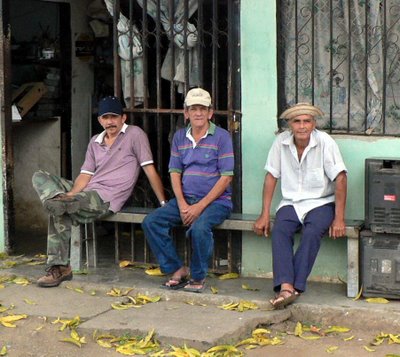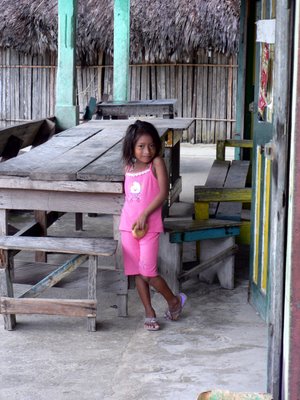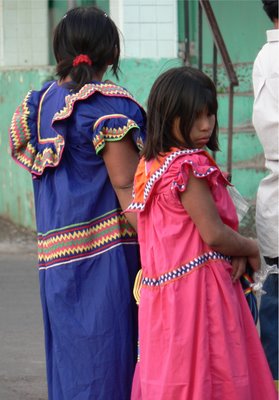
Panama is a country with many contrasts. Because of the Canal and perhaps the long term American influence, Panama City has become a major city. It is the banking capital of Latin American and the money shows. The city wraps around the Pacific Ocean and towering high rise apartments line the waterfront. The immensity and density reminded me more of Hong Kong than Latin America.
It has an old town that looks much like the French Quarter of New Orleans or Havana. For years it was left to rot as the modern part of the city grew. Trees invaded every corner, rooftop and windowsill breaking the walls down one by one. Panama City’s poor filled the tenement-like housing and the area was left to fall down, until visionaries saw the beauty and started the restoration process. What is being restored is a marvelous variety of architecture. Slowly restaurants are moving in as a huge effort to keep tourists safe from crime finds success.
As we were walking in the area, a policeman came up to us and asked us if we wanted a tour. He brought us into the station and handed us piles of tourist lit and we then set off for a tour of the sites. He took us into ornately restored government buildings and through plazas and cathedrals and regaled us with stories and history. Before leaving us he made sure we knew which areas were safe to walk in, since crime is still a major problem there.
The major site in Panama City is the canal. Building the 80 kilometer canal was a major engineering feat and a big victory for the United States, who took over after the French failed. From its opening in 1914 till the end of 1999, the United States controlled the canal and the Canal Zone, the strip of land the canal went through. Now Panama is proud to be in control and running it even more efficiently than the US did. It takes 10% less time for a ship to travel through now then it did in 1999. But even with this efficiency the canal is almost at capacity and efforts are being made to widen it and increase its capacity.
Watching these huge ships rise in the locks was amazing. I have a special place in my heart for freighters, since my grandfather owned a shipping company and I used to travel on his ships when I was young. Today they are much larger but so am I so the perspective is equally impressive.
Outside Panama City the landscape and the people change suddenly. Within a few minutes of driving over the Bridge of the Americas which rises above the entrance to the canal, we were on a long highway with nothing but waves of rolling mountains and countryside as long as our eyes could see. We were driving through ranching country and images of cowboys filled my head. Panama has a very small population of less than 3 million people, so there are large stretches of land that lies wild and untouched.
As luck would have it, we were driving along when we came upon a rodeo in full swing. Teams of men on horseback were competing at rustling steers. When the teams were done they would ride their horses right up to the bar to get a beer and spend the afternoon relaxing with their friends and family.
Here I had the best plate of chicken lo mien I’ve ever had. Yes, the Chinese have a big influence in Panama. They were brought in to build the Panamanian railroad before the canal was built and have stayed ever since. They make up 5% of the population, but seem even more visible than that because they run most of the shops and their diet has been widely adapted. Fried rice is available with almost every meal. American food has been widely adapted too. Hamburgers and hot dogs are available everywhere.
Our destination was Boquete, a small town up in the mountains. While much of Panama is low lying and thus hot and humid, this area has a perfect climate for most of the year, warm during the day and a slight chill at night. These mountain ranges are covered with ancient old growth cloud forest. I’m not sure if this differs from rain forest, since it is at a much higher elevation, but the same birds and animals live in this habitat.
Panama has vast areas of untouched land filled with wildlife and is rapidly becoming “the next Costa Rica.” We drove past 600 year old ash trees that towered high into the sky and were told that the forest is over 2 million years old. Panama has more bird species than all of North America combined and many Quetzals, the ornate bird that people search high and low for in Costa Rica. Unfortunately we were not there in season, but in January you can see 25 Quetzals in one tree in these forests.
One of the new outdoor activities in Boquete is to ride like Tarzan on zip lines through the roof of the forest. A truck drove us up high into the hills and we zipped down on 3 km’s of line over waterfalls, cliffs and lush green forest dropping over 1200 feet.
Boquete is coffee plantation country. The hillsides are all covered with coffee plants. In fact, a farm there was judged the number one coffee in the world earlier this year. We went on a coffee plantation tour and learned more than I’ll ever need to know about coffee, especially considering I don’t even really drink it. It was fascinating none the less and if I ever take on a coffee habit, I might know enough to be a real coffee snob!
Panama has 7 indigenous peoples and most of them maintain their traditional dress and culture. In Boquete, the Ngobe-Bugle come to pick the coffee and live in the area. Their bright colors really lit up this little town.
The big thing we noticed in this area was American real estate developers. Panama is eagerly welcoming American retirees and developers are creating McMansions throughout the hillside. Although we didn’t see many tourists, we did come across many developers as well as new residents who are changing the face of the area. We were told that within two years the population will be 65% American and I'm sure the main streets will look entirely different.
Development is visible everywhere. Many new expensive restaurants have popped up selling all kinds of food from Argentinean steaks to Peruvian seafood. The only thing that was hard to find was a Panamanian meal, but we did manage to find a few of the traditional buffet places and eat smoked pork and stewed chicken. Surprisingly the food most Panamanian’s seemed to want to eat was spaghetti and meatballs, though I never got around to trying it.
After a few days in the mountains, we were ready to head into the heartland, back to cowboys and ranching and the home of most of Panama’s culture. The Azuero Peninsula has a hot hilly landscape and is mostly untouched by the effects of modern life. Towns here look much like they did 100 years ago and life goes on as it did then. The men here wear their straw “panama hats” with the brows flipped up.
This area is off the tourist track so the locals gave us many curious stares. Panamanians in general seemed open and warm and in this area they were even more so. There was lots of waving out of the car and attempts to communicate but with limited Spanish and no English, mostly we could only smile and greet each other, though I’m proud to say my Spanish is better than I thought and I appreciated that they spoke slow.
The last stop on our journey was to the San Blas Islands on the Caribbean coast. This is the home of the Kuna Indians, who run a semi-automous state made up of almost 400 small palm covered islands that line the eastern coast down to Colombia. These indigenous people have been able to survive hundreds of years of conquests. It is thought that they survived European diseases by living on islands separated from the coast and to this day live a traditional lifestyle tightly packed on only 40 of the islands. Men work the on the mainland harvesting coconuts and bananas in the morning and fishing in the afternoon. Women sew molas, which are one of Panama’s most well known handicrafts. They are ornate quilt-like panels that feature traditional designs from Panamanian culture. At any time a large portion of the community is living in Panama City selling the molas to bring money in for their villages.
Getting there was quite a journey. We flew in a tiny plane to one of the islands with an airstrip and rode for an hour in a dug out canoe to arrive on Isla Tigre. This is one of the most traditional of the Kuna islands. 2000 people lived packed into small thatch huts. On one end of the small island, which couldn’t have been much more than a kilometer long, was our little hotel area.
To call it a hotel might be an exaggeration and completely incomparable to what many of you think of as a hotel. Really it was a few thatch huts with cement and sand floors, no electricity and a separate outhouse with a cold water shower and a no-flush toilet, with a big bucket of water beside it. Luckily there were two hammocks hung by the waterside so we could lie in the breeze and gaze at the palm trees, blue sea and rolling waves.
Across the way there was a little restaurant where we were able to get food and nice cold Panama beer, a vacation essential. Because of the total language barrier (Kuna people speak Kuna and some speak a tiny bit of Spanish) we mostly just ate what arrived on our plates. Chicken, fish, rice, fruit and vegetables that pretty much looked the same for every meal. Gourmet food hasn’t hit this place yet.
When I ordered a Coke the waitress wrinkled her nose in confusion and then said “soda?” and ran off. Moments later I was served a lime fizzy drink. Yes, this is the first place I’ve ever been that they didn’t even know what Coke was. Deep in the bush of Africa, you could pull up to any little stand and order a coke, but here nothing. It definitely made me feel that I had traveled way off the beaten path!
The best thing about being on Isla Tigre was the Kuna women. These women dress in traditional dress, which means, a shirt made out of an ornately patterned mola, a wrap around skirt of a totally different bright pattern, a bright yellow and red bandana wrapped around their head, a large metal nose ring and beads wrapped on their entire calves and forearms. Its quiet a sight! It’s a jumble of colors and patterns that isn’t seen often in other cultures and certainly not on the streets of New York.
Being in the San Blas Islands was different than most places one gets to travel, because we were really living among these people. Many times during our days there we walked the loop of the island and as time passed we were able to meet the locals and be introduced to their families. It’s always fascinating to me how despite not speaking the language one can communicate.
We were able to attend a traditional dance that has happened every Friday night for the last 50 years in the same square. The big change on our night was that they had installed a solar light that lit up the square for the first time. Everyone was buzzing about it.
Another lovely experience there was when a few of the children came up to my traveling companion, Grace, and asked to look at her Budget Travel magazine. They looked with awe at the many pictures of different places in the world. Their eyes lit up at the picture of icebergs!
After seeing so many places, it’s a bit hard for me to see the world through their eyes. Their world is a small island and a large sea around it. My world is getting smaller and smaller, though the more places I go the more I hear about and want to go to. My list is so long, I don’t know how I will ever be able to get to it. But I’ll keep going place by place till I’ve seen all I can.
This kind of travel is a real privilege. I enjoy gaining a perspective about my life and what is important. My next journey is to Afghanistan on a women’s delegation in March. I’ll be sure to tell you all about it when I get back!
Check out my photos
Till then, adios!
Cordelia




